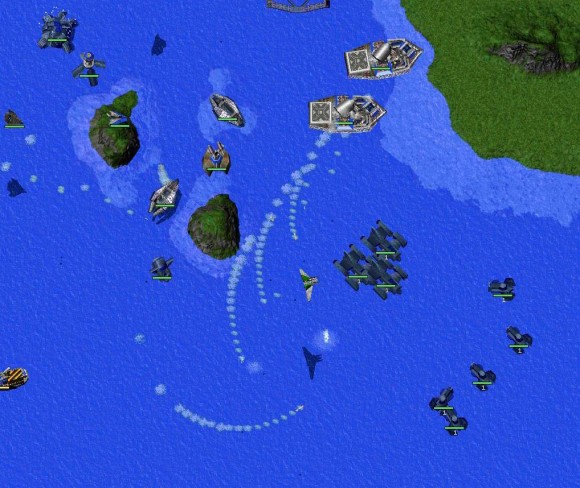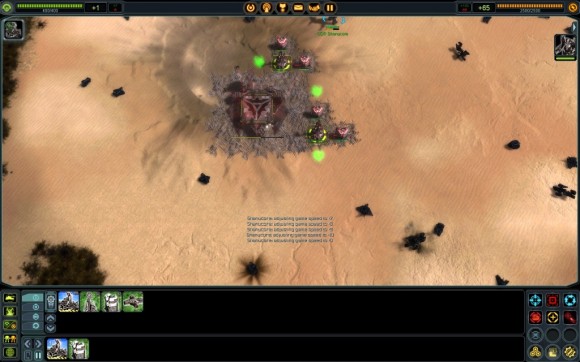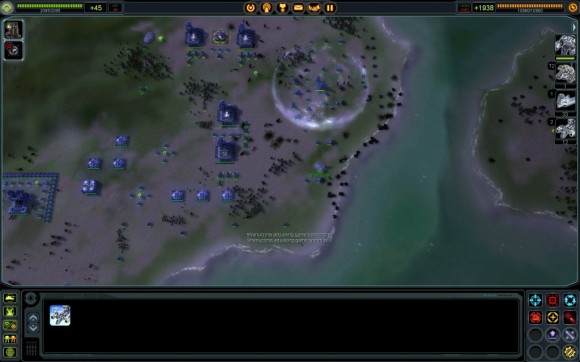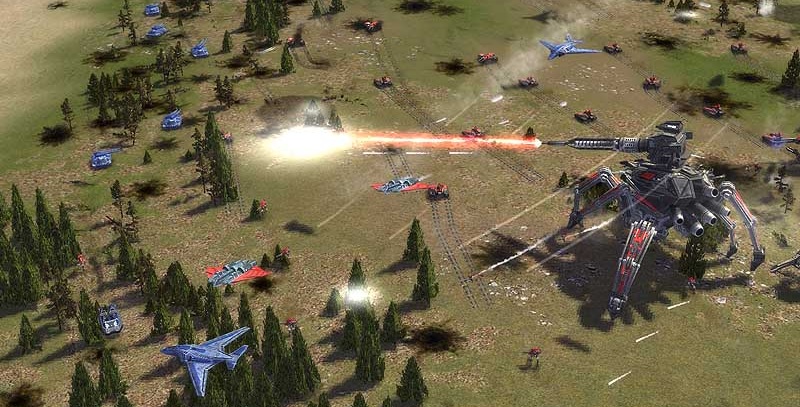Total Annihilation came at the right time for me. It was released in 1997 and I, callow youth as I was, ate it up. Only been a few years before I had discovered first Dune 2 and then Command & Conquer and my love of the RTS genre was in full flow. I’d played a bunch of other RTS games since C&C but none had delivered the magic of Westwood’s classics.
TA offered something different: narratively it had a sense of dramatic large-scale conflict that its predecessors couldn’t match, visually its polygonal graphics were a unique shift from the top-down or isometric hand-drawn sprites that were still more common, and mechanically its economic system was a complete shift from the finite resources of other games. Total Annihilation was all about managing resource flow: you wanted your expenditure to match or fall just short of your income but no less. Failure to fully exploit your income meant you’d fall behind your opponent, be they human or AI.
An early multiplayer experience was humbling: my meagre collection of metal mines and energy collectors was facilitating a steady drip-feed of first level units, but it all came to naught when the friend I was battling showed up with a special unit that took up half my screen. It crushed my base in seconds.
Developers Cavedog Entertainment enjoyed golden boy laurels for a few years and published several reasonably successful expansion packs alongside a steady dripfeed of free units. The latter were particularly cool, beating DLC to the punch by about eight years; Cavedog’s website encouraged fans to download new units every few weeks and add them to the game. Because Total Annihilation used polygonal units rather than sprites adding new designs was a comparatively simple affair, even on the slow dial-up internet connections of the day, and they exploited this to the full.
Alas Cavedog mis-stepped a few years later with Total Annihilation: Kingdoms, a fantasy-themed sequel that did not perform well. I never played it, feeling that the style of visual I’d enjoyed so much in TA’s SF theming did not translate well to a fantasy setting, and further unsure whether the game offered more than an ugly more of the same.

The studio closed not long after and TA creative lead Chris Taylor formed a new studio with a number of other Cavedog employees. The freshly-minted Gas Powered Games released a number of other games and expansions between 2000 and 2005, all in the fairly well-received Dungeon Siege series. Then, in 2007, Taylor and his team returned to their spiritual roots with the release of Supreme Commander.
To those of us who were teenage PC gamers in 1997 this was a cause for great excitement. Despite being ten years older, wiser and almost certainly more cynical, the promise of a return to the large-scale bombast of Total Annihilation supported by modern computing power, game design and graphical technology seemed almost too good to be true.
Upon release the game was broadly well-received. Aside from its impressive scale it received praise for features such as its strategic zoom, which allowed players to shift perspective smoothly from a close-up on a couple of units to a view of the entire map with buildings and units represented by simple icons. In practical terms this meant players could switch at a moment’s notice between executing a complex strategic assault and enjoying the game’s detailed animations for individual units.
Those same impressive visuals were perhaps the source of the game’s greatest struggles: in 2007 the game demanded an expensive gaming rig for a decent performance with all bells and whistles activated, and the PCs many players owned simply weren’t good enough to run the game well.
Regardless, the game’s numerous other innovations were undeniable. Its waypoint system is still fantastic today; it’s a simple matter to queue an almost endless sequence of activities for individual units. When playing through the game recently it wasn’t uncommon for me to set groups of engineers construction tasks that, the game’s sharp UI informed me, they would be working away at for the next hour. The next hour!
Supreme Commander eschewed the ability micro-management and clicks-per minute techniques of other games – such as its ancestor’s 1998 competitor StarCraft, by now thoroughly established as the RTS e-sports daddy – in favour of simple and accessible macro-management tools, allowing players to devote their attention to a broader focus. Speeding up and slowing down the passage of time was similarly useful; for a spell you’d sometimes be doing little more than waiting for a certain building or group of units to be completed, and the ability to increase the game’s speed by a factor of ten was a great boon.

It was an early game featuring multiple monitor support, to boot, a fact I’d actually forgotten until a friend stopped by during my recent playthrough. After setting it up I was suitably impressed, not just that it was possible but also at how much it strengthened my situational awareness and ability to manage my units and plan my tactics.
However, playing Supreme Commander today it’s also clear where some edges are a little rough. The missions in the campaign demonstrate reasonable variation and each mission tends to scale up by expanding to new areas of the map, simultaneously providing a drip-feed of new units, challenges and threats. Unfortunately it’s easy to hit your unit and building cap (which is shared) but find that your defensive line is entirely useless once the map expands. Deleting buildings, especially large numbers of them, is easily the most frustrating aspect of the game, and failing to predict where the next enemy base and assaults are located can put you on the back foot for some time.
The final mission of the first campaign hit me with this and soon turned into a frustrating grind where every three steps forward involved two or more back. Although initially I enjoyed the feeling of hard-fought attrition it stretched out for long enough that it developed into simple repetition, with pure numbers eventually outweighing strategy, and my final victory was a hollow experience without even the resonance of a Pyhrric victory. Fortunately upon starting the second campaign I realised that the margins of the fully-zoomed out strategic map include a subtle cue to indicate where the next expansion will occur, a fact the game itself never bothered to share.
Similarly frustrating is the way the campaign never allows you to play with the gargantuan experimental units. These are some of the most fun creations in the game: much like the screen-spanning entity that exterminated my base in that long-passed game of Total Annihilation they are huge, distinct and extremely powerful. The final level of each campaign forces you to take on the experimentals of your opponents but never lets you play with your own.

This is something the game’s sequel, Supreme Commander 2, clearly understood – arguably to the point of excess. Through its three campaigns players get to both battle and construct a wide variety of experimental units, including launching unfinished experimentals into the field in particular moments of desperation.
That’s not all the sequel brought to the table; improved visuals and unit design distinction were a point of focus, alongside greatly reduced unit variation/redundancy, a higher unit cap, a better narrative complete with forgettable characters and a story about something or other, a research tree system that replaced the original SupCom’s simple three-tier upgrade system, and smaller maps replete with purely decorative scenery. Despite this mixed feature list I think back on Supreme Commander 2 more fondly, enjoying its campaign more than what at times became drudgery in its predecessor. Regardless both games have their respective strengths and I’m pleased to include both in my RTS collection: little pieces of gaming history both.
So where next for Supreme Commander? After publisher THQ’s high-profile collapse into bankruptcy late last year the IP now appears to be held by Nordic Games (alongside other AR-approved titles including Darksiders and Red Faction), although fans of the series are disputing this, arguing that Nordic only hold the rights to the original game and the IP actually rests with Square Enix. While the details of the deal are finalised Nordic are remaining close-lipped so we’ll have to wait and see what we can expect next for the Supreme Commander name. As for Chris Taylor’s Gas Powered Games, they’re now owned by Wargaming.net – another purchase bankrolled by the staggering success of World of Tanks – and haven’t announced a new project since the cancellation of Wildman.
Taylor and GPG aren’t the sole names behind Total Annihilation or Supreme Commander, of course. The recently-formed Uber Entertainment, containing more TA and SupCom alumnus, completed a Kickstarter campaign last September. The game they’re now working on, with a crowdsourced budget of over $2.3m, is Planetary Annihilation – a title which promises to further up the scale of its predecessors by stretching its galactic wars across multiple procedurally-generated planets within each in-game map.
Planetary Annihilation recently released an alpha to Kickstarter backers and other pre-purchasers but, at £68, it’s one alpha Arcadian Rhythms won’t be reporting on. Instead we’ll watch continuing developments at all three companies still related to these classic RTS games, because if we’re sure on one thing it’s that this war isn’t over yet, and if we’re sure on two things, it’s that at some point I’ll get to construct an even bigger robot.

Comments
6 responses to “Retrospective: Supreme Commander”
I played a lot of Supreme Commander 2 during a Sunday afternoon where I was so ill. I loved it but I have never been able to go back.
I'm hoping to go back to it soon and replay at least some of the campaign. Then I might see if I can get into some multiplayer games. I did a couple around the time AR started with some of the guys from Gaming Daily and even though I sucked it was really good fun!
Oh man, you have no idea how good this article was for me. For a while now I've been on the hunt for an RTS which doesn't revolve around micro-management. What you describe above in SupCom reminds me of AI War in that you can zoom right out and move units around as icons and automate a lot of stuff; worrying more about the strategy than nannying my fucking engineers and telling them to fix the bust up tanks they're stood direclty behind. I never did forgive Company of Heroes for that sort of bullshit. And that's apparently one of the best RTS games out there.
AI War suffered from 'blobbing' as it was known over on Arcen's forums where you'd just blob all your units together and wipe a system and move on. There were plenty of other strategies in their but blobbing was a simple tactic that worked in too many situations. AI War was great and I loved the automation and macro-management but it was very hard to get into and tough to sustain for me. It was far from immediate. I think I spent 10 hours on the tutorial alone.
As for my recent foray into Sacrifice: I bounced off the demo big-time a few years ago but decided to give the full game a spin after enjoying the heck out of Brutal Legend. Suffice to say I bounced off it again, perhaps even ricocheted off it. My last outburst was 'OH FUCK THIS', quit the game and a week or so later I uninstalled it. I ought to write about why I think it's unfit for purpose.
After much soul searching, I've realised that my favourite RTS is currently Age of Mythology because it strikes a great balance between a number of things: great UI and controls, fascinating lore, robust and transparent in-game help and information, diverse races, units, structures, abilities and specialisations, an entertaining and meaty campaign, solid skirmishing and multiplayer, the excellent Titans expansion, lovely graphics and music.
And I always preferred the look of TA: Kingdoms Shaun! Sorry! ;-)
Supreme Commander is impressive because, due to the ability to automate a lot of things, it is very manageable on a console.
One of the later levels in the first campaign is suitably epic too with 150 units versus 150 units clashing in spectacular ways. The tutorials are essential but no way is it as terrifying as AI War. As a console gamer I started on AIW and immediately went 'Nope.'
Heh, been trawling through gigabytes of shit on my old drives and found a screenshot entitled 'Welcome to the Tutorial':
http://i.imgur.com/cSe1FeW.jpg
Welcome.
Hey Gregg, gad you dug the retrospective!
I've actually found that in the original SupCom engineers set to patrol still require some nannying to repair the damaged units that are right next to them. They prefer to harvest wreckage and nearby trees instead, even when your resources are tip-top. Idiots. But that, and certain multi-unit formations, are my main UI frustration, and relatively easy to circumvent.
I've played half the tutorials in AI War and then not gone back to it. Am I a bad person? I would probably have loved it had I played it five years ago. Sacrifice and Age of Mythology are two RTS games I've not yet gotten round to, despite hearing marvellous things about them.
Oh, and glad to find another Brutal Legend fan! Some severe balancing issues in there, but such a fantastically entertaining experience I couldn't care less. Brutal Legend is underrated.
P.S. …really?
http://pcmedia.ign.com/media/reviews/image/takip0…
Bleurgh.
;')